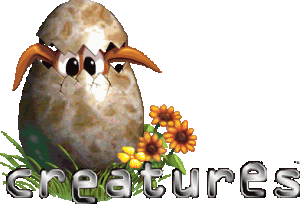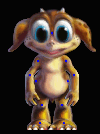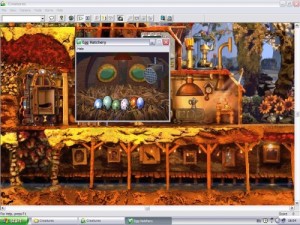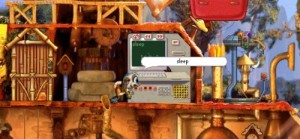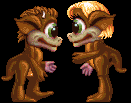You are currently browsing the tag archive for the ‘Androids’ tag.
I know I said that this wasn’t just a retro game blog, but that doesn’t mean I can’t talk about retro games…
Besides, this isn’t so much a game as it was (as Wikipedia has helpfully phrased it) an “Artifical Life Program”. I’m talking about this:
This is one of the first games I played on a PC (at least a one in my house). I’m not going to argue about what classifies a “game” here, I’ll save that for another time. One of the main reasons why I’m hesitant to dismiss it for what it looks like (it looks like neopets or something, which is selling it short) is because it was designed by a most interesting man. His name is Stephen Grand OBE. And the following is the abstract to a paper he penned with Dave Cliff published in 1998 entitled Creatures: Entertainment Software Agents with Artifical Life:
We present a technical description of Creatures, a commercial home-entertainment software package. Creatures provides a simulated environment in which exist a number of synthetic agents that a user can interact with in real-time. The agents (known as ’’creatures‘‘) are intended as sophisticated ’’virtual pets‘‘. The internal architecture of the creatures is strongly inspired by animal biology. Each creature has a neural network responsible for sensory-motor coordination and behavior selection, and an ’’artificial biochemistry‘‘ that models a simple energy metabolism along with a ’’hormonal‘‘ system that interacts with the neural network to model diffuse modulation of neuronal activity and staged ontogenetic development. A biologically inspired learning mechanism allows the neural network to adapt during the lifetime of a creature. Learning includes the ability to acquire a simple verb–object language.
Additionally, both the network architecture and details of the biochemistry for a creature are specified by a variable-length ’’genetic‘‘ encoding, allowing for evolutionary adaptation through sexual reproduction. Creatures, available on Windows95 platforms since late 1996, offers users an opportunity to engage with Artificial Life technologies. In addition to describing technical details, this paper concludes with a discussion of the scientific implications of the system.
That’s long form for “This isn’t a Tamagochi”. Notice how he refers to it as Artifical Life, not intelligence. It sounds like something Peter Molyneux would say about the dog in Fable 2, but with this I think the meaning is much deeper. Stephen Grand OBE (I’m always going to put the letters on, it’s amazing) is a Computer Scientist from Cambridge. After he finished Creatures (and its sequels) he moved, I believe, to Louisiana to set up a company renting low cost ANDROIDS for marketing (Grandroids it’s called, and I urge you to look HERE)!! His pride and joy, however, is the mechanical ORANGUTAN, Lucy. That’s an oranguatan with the simulated mind of a BABY. And it looks terrifying. I’ll step back a bit, and summarise the core mechanics of Creatures.
The game is set on a disc shaped planet called Albia. That has been abandoned by an intelligent race that lived there. They seem to have left behind a lot of stuff, including a lab with some computers in, and an incubator containing 6 eggs. The game is presented in a 2D painterly style, and quite remarkably, the design for the one (scrolling) environment was drawn directly from a huge real life model that Stephen Grand OBE made!
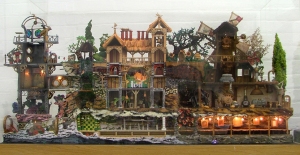
It was drawn up by Mark Rafter and created by Complete Fabrications, a team of local model-makers who were used to making models for museums. It cost around £15,000 to make.
The player chose an egg and hatched it in the incubator, controlling the game with a point and click/drag interface. Once it hatched you had this:
That one reminds me of Dakota Fanning. Anyway, this thing came out as a baby crawling on all fours. And that was it. Nothing telling you what you had to do (it ran in a window on Windows 95, so you could go to help and read topics there, and there was an optional tutorial video which explained the interface), and no set “goal” as such. The implication is to not let this chap die. Directly above the birthing area there is a computer. As you can freely scroll around and click on what you want you can glean by the combination of sound, and the display that it is a computer for teaching the “norns” (that’s what they’re called) verbs. It has “go” and “use” and all that on there. You can type in commands yourself, and your hand of god will say it. Whether or not it is always understood or listened to is another matter. So once you managed to tease it to the lift that takes it to the computer (like real babies picking up a ball or something shiny and waving it in their face tends to do the trick) and you’ve sat it down long enough to learn some basic commands (with a combination of as much carrot or stick treatment as you like) you can try exploring.

This was just one of many multi-tabbed windows in which you could monitor your norn. The complexity behind this world was astonishing.
The one thing your norn (and eventually norns) had to worry about (besides disease – which you could medicate, food – which you could provide, alcoholism – which… well you could try telling them off) was this:
As you can see by his smiling face he wasn’t much harm… or was he. He’s the grendel. His major sin in life is that he’s different to the norns biologically. If they hang around him too much they may catch diseases. His temprament is also questionable, and he’s been known to attack the odd norn. What a sod. But I always overlooked this. I kept them seperate, but this game never teaches you to be malevolent toward this happy go lucky scamp, and I applaud it for that. I ended up taking him to the computer one day and teaching him English. I also taught him a few swear words because I thought it was “in character”. I looked up the name of their language on the Creatures Wiki – it’s called “Bibble”.
Scattered around you small (but also open world, I should say) environment were many herbs, foods, and so on, and they all had an effect on your norn when they (inevitably) ate some for a laugh (it’s like being a real parent I imagine, the dread you feel when you hear the swallow sound effect and wonder what they’ve ingested now). And the numerous line graphs and charts you could look up to monitor your norn’s vitals made it a very complex game to play indeed. Then they’d breed. And that was amazing, because they’d look different, they’d be combinations of the different kinds. As a kid it astounded me.
As a life simulator I’ve not seen anything remotely as complex as this as either part of a game, or the basis of one itself (The Sims may be well and good, but norns learned, and developed behavioural patterns over the course of their lives – as opposed to a Sim wandering around switching every electrical appliance on, and then wetting itself). The world was small, but immensely charming, and beatifully drawn (based off that beautiful – if a bit extravagant model). And to its credit the game provided some emotional experiences, especially should you see a norn turn to face you with a sad look on its face because of something you had done or said; or when you notice them reach old age and eventually die. No other life sim has ever made me consider life and death so poignantly, and it was because it was done so elegantly and without drama. For a Computer Scientist who referred to his creations as “Synthetic agents” he was suprisngly good at pulling the old heart strings and thinking about it last night this game got so much right, and was ahead of the curve on so many levels I feel a bit ashamed of my countrymen for this not being one the best remembered British games of the 1990s.
Mike Dunbar
Creatures went on to spawn two sequels, and have a healthy online existence due to a large modding community. It’s review scores at time of release were very high, earning 94% from PC Zone, 80% from PC Gamer. However, the Playstation version which was released some years later recieved generally unfavourable reviews, presumably as it lacked the windows interface which make the PC version so accessible. Luckily, Good Old Games are selling Creatures: The Albian Years (a compilation of the first two games and all their expansion packs) for a tenner, and it runs on XP. You’ve no reason not to get it.
http://www.gog.com/en/gamecard/creatures_the_albian_years

